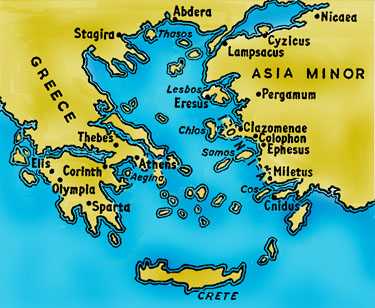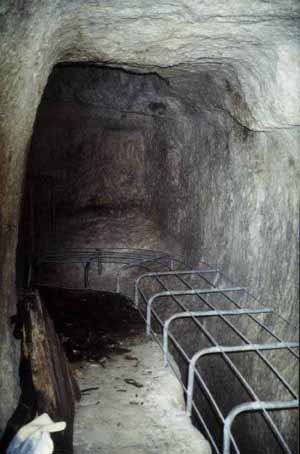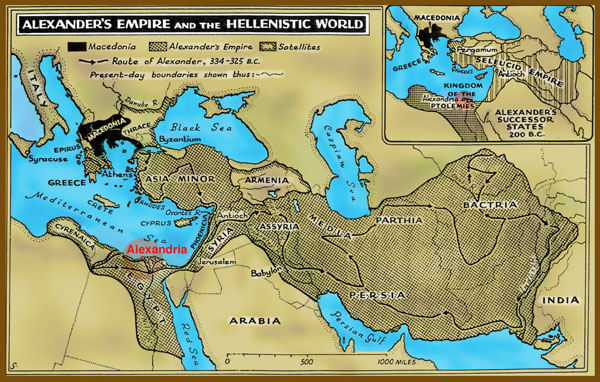
University of California, Irvine
Instructor: Dr. Barbara J. Becker

|
Lecture 3. Shaping the Stuff of Everyday Strife
|

The Greeks Surrounded on all sides by water, denizens of the Greek peninsula in 1000 BCE were a seafaring people. By 800 BCE, they had colonized the many islands and coastal shores of the Ionian, Adriatic and Mediterranean Seas. Their desire to map not only their local environs, but the world at large, led them to become avid students of the sky and skilled navigators. By the start of the Classical period in the 5th c BCE, Greeks -- particularly those living in the colonies -- had participated with enthusiasm in technological advance. The names of notable contributors became associated with important innovations:
Whether or not these attributions are accurate, the celebrity according these individuals shows a certain esteem for expertise derived from the practice of techné -- the acquisition of knowledge of the world through direct hands-on experience. Illustrations from this period show men working directly on or in the ground, and at benches or low-lying tables. At least, for a time, to be interested in technology was respectable in Greek society and inventors were regarded as benefactors. |
|||||||||
[T]hree of the greatest works in all Greece were made by [the residents
of the island of Samos]. One was a tunnel, under a hill one hundred
and fifty fathoms high, carried entirely through the base of the hill,
with a mouth at either end. The length of the cutting is seven furlongs
(1 furlong = 1/8 mi) -- the height and width are each
eight feet. Along the whole course there is a second cutting, twenty
cubits deep (1 cubit = length from the fingertips to the
elbow) and three feet broad, whereby water is brought, through pipes,
from an abundant source into the city. The architect of this tunnel
was Eupalinus, son of Naustrophus, a Megarian.
Herodotus (c.484-525 BCE), The History, Book III.60 (c. 450 BCE) |

The tunnel and aqueduct of Samos. Viewed in elevation, they follow a straight and gentle downward slope from the spring to the city. Viewed from overhead, the water channel meanders through the hills between the source and the north entrance to the tunnel, then follows a nearly straight line to the tunnel's south entrance at which point it curves and heads downhill toward the city. |
| Around 520 BCE, Polycrates, the ruler of Samos, commissioned Eupalinos
of Megara to construct a tunnel and aqueduct to bring fresh water from
a distant natural spring to the harbor city called Samos (now Pythagorion).
Unfortunately for Eupalinos, the spring and the city are separated by a
range of hills and small mountains. A meandering channel was built
to carry water from the spring through the hills, but to cross the mountain
range, a tunnel had to be dug in order to reach the city. After considerable
planning, work on the tunnel was begun simultaneously at both ends.
The two digging crews accomplished this challenging task almost without
a hitch: As they approached one another in the middle of the mountain,
they found their tunnels were separated laterally by about 5 m requiring
a corrective turn to connect them--not too bad considering the tunnel is
over 1000 m long!
To find out more, see Dan Hughes's and Hans Keller's informative and well-illustrated website: "The Tunnel of Eupalinos". |
 |

The death of Alexander in 323 BCE marked the end of Greek's Classical period and a long phase of creative technological development in the Western world. No new raw material was exploited for the next thousand years. Other than the discovery and development of glassblowing techniques, no really novel method of production was introduced. All new advances were made in the field of engineering based on principles that had already been discovered and applied. The reasons for this are complex, but stem largely from a lack of incentive to invent. After all, why bother developing labor-saving devices when the "dirty" end of production and upkeep has been put entirely into the hands of expendable slaves? This attitude toward working with one's hands was engendered and bolstered by cultural norms established in the Classical period that favored intellectual over physical pursuits. The elite class did not look down upon all physical activity. Excerise was necessary to maintain health and improve the body. But physical labor only damaged the body. Besides, any time spent on physical labor took valuable attention away from one's duties as a good citizen. The scales were tipped in favor of episteme over techné as the way to gain knowledge of the world. Respectable occupations involved civic leadership as a politician, a philosopher, a jurist or military officer. The job of running industry, commerce and agriculture was placed in the hands of a new class composed of lower-grade administrators and civil servants. Creativity and innovation was not disparaged. It was acceptable to be an artist if one had slaves to do the physical labor. In the same way, engineering was viewed as an honorable profession. Engineers were employed to design the infrastructure and war machinery needed to keep the public safe and comfortable -- and the civic leaders' reputation in good standing. The greatest engineer of the Hellenistic period was Archimedes (287-212 BCE), but few of his inventions could have been as efficient in practice as they were in theory. Hero of Alexandria (fl. 62 CE) developed many clever devices based on a few simple principles -- the siphon, spring, screw, pulley, lever, cogs, cams, valves, and air pressure. Hero's gadgets were inventive, but they were generally intended as amusements and had no real productive purpose. Perhaps this is why full advantage was not taken of them. It is remarkable how clumsy in construction and materials the machines of this period were. The materials available and the means for shaping them were inadequate to manufacture equipment of such sophisticated design. |
||||||||||||||||||||||||
|
(Hellenistic Period--Greek influence)
(Roman Empire--Greeks)
One of Hero of Alexandria's many ingenious, but ultimately impractical, designs for steam-operated automata. The fire (on the lower left of the illustration) heats the air in the sphere above it. As the air expands, it exerts pressure on the water in the vessel attached to the sphere. The pressure pushes water up the siphon and into the adjoining container. This container is connected to a rope which is coiled around a pole. As the container fills with water, its increased weight causes it to drop. As the container falls, it tugs on the rope causing the pole to pivot and open the door to which it is attached. |
|